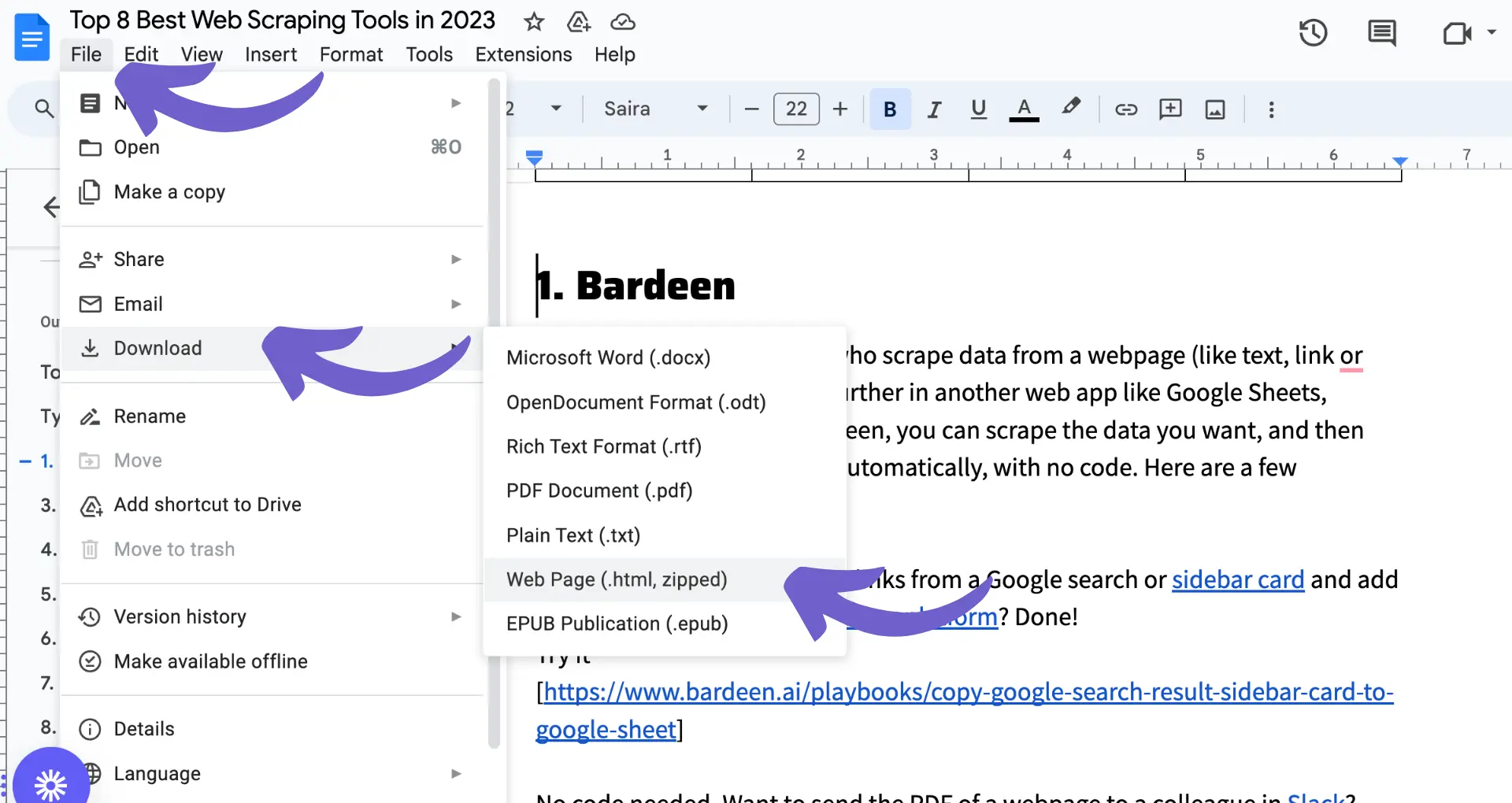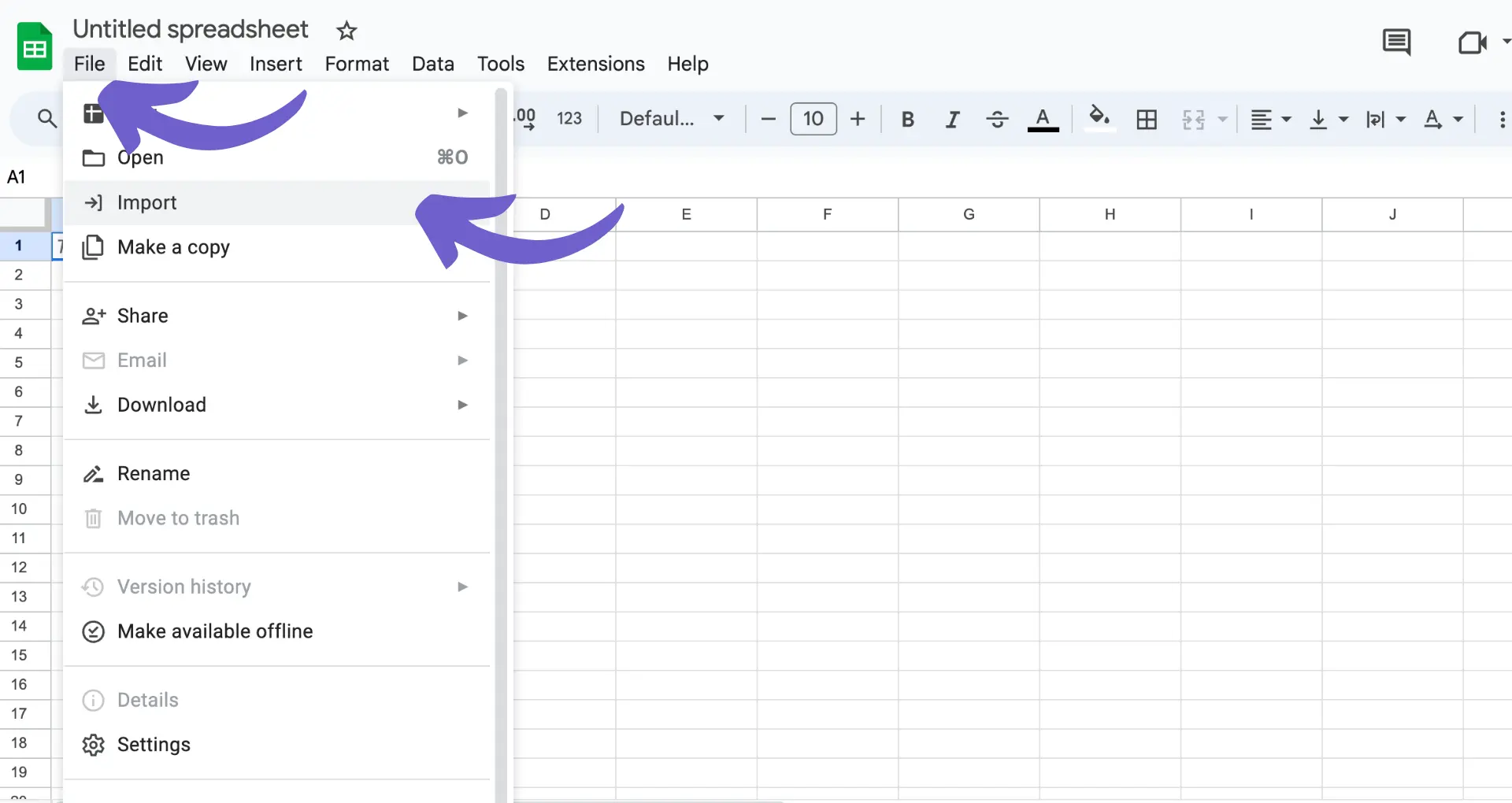Download your Google Doc as a CSV file and import it into Sheets.
By the way, we're Bardeen, we build a free AI Agent for doing repetitive tasks.
If you're converting documents, you might love Bardeen's automation for Google Docs. It can save you time and effort by automating document conversion and data transfer.
Converting a Google Doc to a Google Sheet is a straightforward process that can save you time and effort when working with data. In this step-by-step guide, we'll walk you through the process of transforming your Google Docs into organized and functional Google Sheets. By following these simple steps, you'll be able to easily convert your documents and start analyzing your data in no time.
Understanding the Basics of Google Docs and Sheets
Google Docs and Google Sheets are both part of the Google Workspace suite of productivity tools. While they serve different purposes, they can work together seamlessly to help you organize and analyze your data more effectively.
- Google Docs is a word processing application that allows you to create, edit, and collaborate on documents in real-time.
- Google Sheets, on the other hand, is a spreadsheet application designed for working with structured data, performing calculations, and creating charts and graphs.
Converting a Google Doc to a Google Sheet is particularly useful when you have data in a document that you want to analyze or manipulate using the powerful features of a spreadsheet. By transforming your data into a structured format, you can easily sort, filter, and apply formulas to gain valuable insights and make data-driven decisions. Explore how to bring AI into your spreadsheet for more advanced data analysis.
Preparing Your Google Doc for Conversion
To ensure a smooth conversion process from Google Docs to Google Sheets, it's essential to structure your document with tabular data in mind. Here are some tips to help you organize your data effectively:
- Arrange your data in a clear, grid-like format using rows and columns. Each row should represent a single record, while each column should represent a specific attribute or field.
- Use consistent formatting throughout your document. Ensure that all data in a column follows the same format (e.g., dates, numbers, or text) to avoid any confusion during the conversion process.
- Include headers at the top of each column to clearly identify the type of data it contains. This will make it easier to understand and work with your data once it's in Google Sheets.
By taking the time to structure your Google Doc properly, you'll be able to convert it to a Google Sheet with minimal issues, allowing you to take full advantage of the spreadsheet's powerful data analysis and manipulation features.
Save time converting documents by using Bardeen's feature to integrate Google Drive with other apps. Automate tasks and focus on important work!

Exporting Data from Google Docs
To export your data from Google Docs to a format compatible with Google Sheets, follow these step-by-step instructions:
- Open your Google Doc containing the tabular data you want to convert.
- Click on "File" in the top menu, then select "Download" from the dropdown list.
- Choose either "Plain Text (.txt)" or "Comma-Separated Values (.csv)" as the file format, depending on your preference. CSV files are generally more compatible with spreadsheet applications like Google Sheets.
- Click "OK" to confirm the download and save the file to your computer.

It's crucial to select the appropriate file format during the export process to maintain data integrity. CSV files preserve the structure of your tabular data, ensuring that it can be easily imported into Google Sheets without any loss of information. For more advanced data handling, you can integrate Excel with Google Sheets.
Importing Data into Google Sheets
Now that you have exported your data from Google Docs in a compatible format, it's time to import it into Google Sheets. Follow these steps to import your data:
- Open Google Sheets and create a new spreadsheet.
- Click on "File" in the top menu, then select "Import" from the dropdown list.
- In the "Import file" dialog box, click on the "Upload" tab and then click "Select a file from your device."

4. Locate and select the exported .txt or .csv file from your computer, then click "Open."
5. Choose your preferred import options, such as "Replace spreadsheet" or "Insert new sheet." "Replace spreadsheet" will overwrite any existing data in the current sheet, while "Insert new sheet" will create a new sheet within the existing spreadsheet to house the imported data.
6. Click "Import data" to complete the process.

Google Sheets offers various options to customize your data import, such as specifying the separator type (comma, semicolon, or tab) and indicating whether your data includes a header row. For more advanced features, you can enrich LinkedIn profiles directly in your sheets. Adjust these settings according to your exported file's format to ensure a smooth import process.
Use Bardeen to enrich LinkedIn profiles in Google Sheets. Save time and make sure your data is up-to-date.
Final Adjustments and Best Practices
After importing your data into Google Sheets, you may need to make some final adjustments to ensure your spreadsheet is organized and easy to read. Here are some tips:
- Adjust column widths: Double-click on the right border of a column header to automatically resize the column to fit the content. Alternatively, click and drag the right border to manually adjust the width.
- Format text: Use the formatting options in the toolbar to change font size, color, and style. Consistent formatting makes your data more readable.
- Check for data accuracy: Review your imported data to ensure everything transferred correctly. Look for missing or misaligned data, and make any necessary corrections.
To maintain data quality in Google Sheets, consider these best practices for data enrichment:
- Use formulas: Formulas help automate calculations and ensure accuracy. Common formulas include SUM, AVERAGE, and IF statements.
- Implement data validation: Set up data validation rules to restrict the type of data that can be entered in specific cells, such as numbers only or values from a dropdown list.
- Organize with tabs: Divide your data into multiple sheets within the same spreadsheet file to keep related information together while maintaining a clear structure.
- Regularly review and update: Periodically check your spreadsheet for errors, inconsistencies, or outdated information. Keep your data current and accurate.
By following these final adjustments and best practices, you'll create well-organized, accurate, and easy-to-understand Google Sheets that effectively convey your data insights.
Automate Google Docs to Sheets with Bardeen
While converting a Google Doc to Google Sheets manually is a straightforward process, automation can significantly streamline and enhance your workflow, especially when dealing with data updates and management. Bardeen offers powerful automation solutions that can help you manage your data between Google Docs and Google Sheets more efficiently.
- Copy all Github issues to Google Sheets: Ideal for developers and project managers, this automation transfers all your GitHub issues into a Google Sheets spreadsheet, making issue tracking and management seamless.
- Save data from the Google News page to Google Sheets: For researchers and content creators, this playbook automates the process of gathering the latest news information into a spreadsheet, streamlining content curation and research.
- Copy records from SmartSuite to Google Sheets: Perfect for teams using SmartSuite for business operations, this automation ensures seamless data transfer to Google Sheets for enhanced reporting and analysis.
Embrace the power of automation to make your data management tasks between Google Docs and Google Sheets more efficient. Start by downloading the Bardeen app today.






.svg)
.svg)
.svg)
